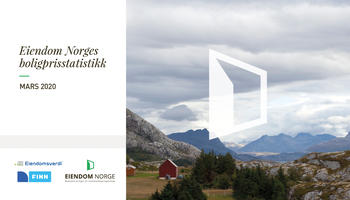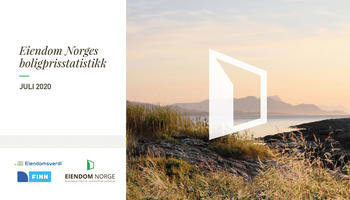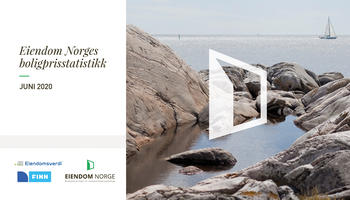
Moderate development in housing prices in July
Housing prices fell by 1.1 per cent in July. Adjusted for seasonal variations, prices fell by 0.2 per cent.
House prices are now 8.5 per cent higher than a year ago.
- House prices in Norway developed weakly in July, which is normal for the month. July last year was exceptionally strong both in price development and sales. Now we are back to the normal economic cycle in the housing market, says CEO of Eiendom Norge, Henning Lauridsen.
- We expect a slight rise in house prices in August, before prices that will normally fall through the autumn. We also believe that the warning interest rate increase in September from Norges Bank will have an impact on house price developments in the future, says Lauridsen.
Large turnover so far in 2021
In July, 5,041 homes were sold in Norway, which is 26.1 per cent less than in the corresponding month in 2020.
So far this year, 61,035 homes have been sold in Norway, which is 6.3 per cent more than in the same period in 2020.
In July, 3,761 homes were put up for sale in Norway, which is 19.5 per cent less than in the same month in 2020.
So far this year, 58,909 homes have been put up for sale in Norway, which is 8.4 per cent more than in the same period in 2020.
- Many homes were sold in July, although there are significantly fewer than in July 2020. But compared to the years before 2020, the volume is high. We expect that the growth in the number of sales will continue in the coming months. The demand for housing is great in Norway now, even though the announced interest rate increase in September will reduce purchasing power somewhat, says Lauridsen.
It took an average of 45 days to sell a home in July 2021, down from 29 days in June. Bergen had the shortest sales time with 20 days and Ålesund with the surrounding area had the longest sales time and Stavanger with the surrounding area with both 54 days.
- On average, so far in 2021 it has been a little faster to sell a home in Norway in recent years. The fast sales time testifies to an efficient and well-functioning housing market, says Lauridsen.
Follo strongest
Follo had the strongest seasonally adjusted price development in July, with an increase of 0.6 per cent. Kristiansand had the weakest seasonally adjusted price development with a decrease of 1.1 per cent.
Bodø / m Fauske had the strongest development in the last 12 months, with an increase of 14.7 per cent. Ålesund and the surrounding area had the weakest development in the last 12 months with an increase of 4.9 per cent.
- The 12-month growth is now declining all over the country, and we expect that it will continue to decline throughout the autumn after the sharp rise in house prices in 2020 and the first quarter of 2021, Lauridsen says.
Housing policy in the 2021 election
- Housing policy, the housing market and inequality are emerging as an important topic in the election campaign in 2021. Our estimates indicate that there is a need for around 300,000 new homes in Norway in the 2020s. These must be built both sustainably and environmentally friendly, but they must also have a price that allows people with regular incomes to buy them, says Lauridsen.
- This is because the tightening of the mortgage regulations from 1 January 2017 has significantly reduced the possibility of becoming a homeowner in Norway.
The nurse index prepared by Eiendomsverdi and published by Eiendom Norge shows that the combination of the regulations and high house prices makes the threshold for becoming a homeowner very high.
In central Eastern Norway, a single nurse can now only buy 3-5 per cent of the homes, provided he has the equity required.
- Eiendom Norge believes we must lower the threshold for homeowners in Norway, says Lauridsen.
The authority can do this through, among other things, the following measures:
- Adequate housing construction is price-reducing. What, how much and where the municipality regulates residential areas is of great importance. Municipalities must therefore be aware of their role as market regulators in the housing market. This applies especially to Oslo Municipality, where the pressure is greatest.
- The state deprives people of their equity through the document fee when buying a home. For an average home of NOK 3 million, this amounts to NOK 75,000. A new government must remove the document fee, as the Conservatives and the Green Party support. Alternatively, the most affordable homes must be exempted from document fees, as SV advocates.
- In the last 20 years, it has become significantly more expensive and more complicated to build homes. The building regulations and planning regulations must be continuously evaluated for increased quality, efficiency and cost reduction. Norway must co-operate with the other Nordic countries to harmonize building regulations in order to achieve a sharp reduction in the cost of housing production.






